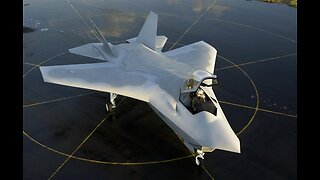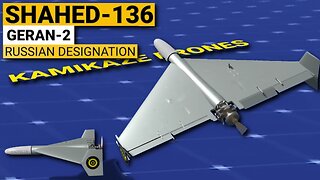Russia's Lancet 3 suicide drone (loitering munition). AK-47 of drones. Cheap, reliable and precise
The Lancet is a Russian loitering munition or suicide drone. It was designed by the ZALA Aero Group which is part of the Kalashnikov Group.
The main roles of the Lancet are reconnaissance and attack missions. During the initial part of the flight the drone can be directed with GPS coordinates or visually. During the terminal part, when it is approaching its target, the drone is controlled manually via electro-optical guidance and a TV guidance unit. This allows to adjust trajectory and guide the drone to its target in real time. The drone includes intelligence, navigation and communication modules.
The Lancet has a rather unusual shape. Two pairs of X-shaped wings are installed at the front and rear of the fuselage. It’s powered by an electric motor that drives a two-bladed propeller located at the rear. The standard version has a maximum range of 40 kilometers and an endurance of around 40 minutes. The weight is only 12 kilograms thanks to the use of plastic and composite materials in its structure. Such suicide drones are capable of hovering in the air and diving down on the target at a speed of up to 300 kilometers per hour to hit it on its most vulnerable part.
The ZALA Aero Group has developed two versions of the drone the Lancet-1 and the Lancet-3. The Lancet-1 is a lightweight version intended for reconnaissance missions, while the Lancet-3 is a standard version capable of carrying a payload of 3 kg. Later reportedly an improved model emerged with a 5 kg warhead.
In June 2022 Russian defense corporation Rostec announced that Lancet has been deployed in Ukraine.
Russian Lancets have three types of warheads – cumulative, high-explosive, and thermobaric. This allows them to increase the flexibility of their use and engage targets such as armored vehicles, including heavy tanks, artillery, radar, air defense systems, and the enemy manpower.
Lancet’s speed is impressive. In search or tracking mode, the drone can reach speeds between 80 kilometers per hour and 100 kilometers per hour. However, when the target is already intercepted, the drone increases its speed to 300 kilometers per hour to ensure greater efficiency of the damage it is expected to inflict.
The Lancet-3 drone is easily portable.
The drone uses an electric motor to operate at the lowest noise level. This type of electric motor is used for surprise attacks and this method has a significant psychological effect on the enemy. The drone has no provision for landing as it is designed to self-destruct when it hits enemy targets. The drone is also capable of crashing into enemy drones.
The Length of the drone: 1.65 meter
Wingspan: 1 meter
It can be noted that this is a family of scalable devices, so in the future there is a chance to see a more powerful Lancet drone, made according to the same design scheme.
Both models - "Lancet-1" and "Lancet-3" are built according to the aerodynamic scheme of double X-shaped wings. The use of X-shaped wings provides loitering ammunition with advantages when diving at a target and performing maneuvers, and the chosen scheme also made it possible to reduce the size of the product.
The drones received the name "Lancet" not by chance but because of their high accuracy. A drone can fly tens of kilometers and strike a target with surgical precision. The strike can be observed online, up to the contact of the loitering ammunition with the target. This is achieved due to the presence of a television communication channel on the drone.
the UAV system's advantages:
• first, the loitering air munition saves time because it is already deployed in the air, ready and waiting to strike the enemy;
• secondly, it's small, light, and made of plastic and composite materials - it's therefore "invisible" to traditional air defence radars;
• thirdly, it's considerably cheaper to strike a target with a kamikaze drone than to destroy it with a high-precision projectile, which requires a self-propelled gun with a crew and a gunner.
The UAV is "smart," "multipurpose," and capable of autonomously finding and hitting the target. The Lancet is equipped with a precision strike component.
According to the ZALA Aero website, the drone "creates its own navigation field" and does not require ground or sea-based infrastructure or satellite navigation. The UAV also transmits video so a human can confirm target engagement. At the same time, the Lancet's built-in anti-laser protection.
The Russia-made UAV has already earned a nom la guerre "flying Kalashnikov" (or "flying AK-47") due to its simplicity, usability, and reliability.
-
 8:02
8:02
Petawawa19
1 year agoRussia's MIG-41: Future 6th generation, multi-role, long range fighter- interceptor
195 -
 4:35
4:35
Military Technologies, Innovations & Future Weapons
1 year agoFinally: Russia upgrades S-70 Okhotnik to 6th generation stealth drone - MilTec by TechSoul
212 -
 3:09
3:09
videos221
1 year agoIran's Arash 2 world's longest-range suicide drone with high precision
78 -
 2:57
2:57
benjaminzmiller
1 year agoUkraine has developed a new drone for HIMARS aiming.
298 -
 16:06
16:06
Military Technologies, Innovations & Future Weapons
11 months agoSu-75 Checkmate - Russia's INSANE New Fighter Jet! - Better than the F-35? MilTec
8561 -
 8:08
8:08
Military Technologies, Innovations & Future Weapons
1 year agoAt a distance of 1,500 km, Russia's Su-57 will be able to control 4 unmanned combat aerial vehicles
9081 -
 4:54
4:54
The Inconvenient Truth!
1 year ago $0.04 earnedThe Russian's Scandalous Flying Doritos!
439 -
 1:57
1:57
TraderOne
1 year agoOrlan 10 - Russian recon drone
5 -
 0:33
0:33
DaniShow
1 year agoukraine-drone
26 -
 38:55
38:55
MILITARYVIDEOS
1 year agoS-70 Okhotnik-B Russian Advance Drone
13